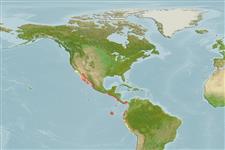Elasmobranchii (Haie und Rochen) (sharks and rays) >
Carcharhiniformes (Ground sharks) >
Carcharhinidae (Requiem sharks)
Etymology: Rhizoprionodon: rhiza (Gr.), root; prion (Gr.) saw; odon (Gr.), tooth, referring to teeth with serrated (saw-like) bases, or roots [replacement name for Rhizoprion Ogilby 1915, preoccupied by Rhizoprion Jourdan 1861 in mammals]. (See ETYFish); longurio: Latin for a tall person, or a “slender youth or stripling” per Jordan & Evermann (1896), allusion not explained, perhaps referring to small, slim body of holotype (a male, presumably mature at 76.2 cm long), much smaller than its presumed congeners in Carcharias (original genus). (See ETYFish).
More on authors: Jordan & Gilbert.
Environment: milieu / climate zone / depth range / distribution range
Ökologie
seewasser benthopelagisch; tiefenbereich ? - 100 m (Ref. 96339). Subtropical; 35°N - 17°S, 121°W - 73°W
Eastern Pacific: southern California, USA to Peru.
Length at first maturity / Size / Gewicht / Alter
Maturity: Lm 63.5, range 58 - 69 cm
Max length : 110 cm TL Männchen/unbestimmt; (Ref. 244); 154.0 cm TL (female)
Adults are found on the continental shelves, more commonly on the littoral zone. Possibly to 154 cm. Viviparous (Ref. 50449). Size at birth 33 to 34 cm. Utilized fresh or frozen for human consumption and also for fishmeal.
Distinct pairing with embrace (Ref. 205). Viviparous, placental (Ref. 50449).
Compagno, L.J.V., 1984. FAO Species Catalogue. Vol. 4. Sharks of the world. An annotated and illustrated catalogue of shark species known to date. Part 2 - Carcharhiniformes. FAO Fish. Synop. 125(4/2):251-655. Rome: FAO. (Ref. 244)
IUCN Rote Liste Status (Ref. 130435)
Bedrohung für Menschen
Harmless
Nutzung durch Menschen
Fischereien: kommerziell
Mehr Information
ReferenzenAquakulturAquakultur ProfilZuchtlinienGenetikElectrophoresesVererbbarkeitKrankheitenVerarbeitungNutrientsMass conversion
PartnerBilderStamps, Coins Misc.LauteCiguateraGeschwindigkeitSchwimmstilKiemenoberflächeOtolithsGehirngrößeSehfähigkeit
Tools
Zusatzinformationen
Download XML
Internet Quellen
Estimates based on models
Preferred temperature (Ref.
123201): 18.1 - 28.7, mean 24.6 °C (based on 106 cells).
Phylogenetic diversity index (Ref.
82804): PD
50 = 0.5078 [Uniqueness, from 0.5 = low to 2.0 = high].
Bayesian length-weight: a=0.00427 (0.00199 - 0.00915), b=3.11 (2.94 - 3.28), in cm total length, based on LWR estimates for this Genus-body shape (Ref.
93245).
Trophic level (Ref.
69278): 4.2 ±0.7 se; based on diet studies.
Widerstandsfähigkeit (Ref.
120179): niedrig, Verdopplung der Population dauert 4,5 - 14 Jahre. (Fec assumed to be <100).
Fishing Vulnerability (Ref.
59153): Very high vulnerability (90 of 100).
Nutrients (Ref.
124155): Calcium = 14.1 [1.9, 80.3] mg/100g; Iron = 0.633 [0.168, 1.855] mg/100g; Protein = 21.5 [18.6, 23.7] %; Omega3 = 0.276 [0.118, 0.584] g/100g; Selenium = 20.7 [6.3, 61.3] μg/100g; VitaminA = 18.8 [6.6, 54.8] μg/100g; Zinc = 0.484 [0.228, 0.887] mg/100g (wet weight);
